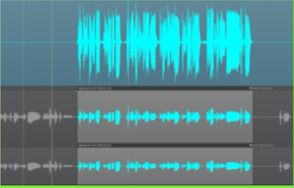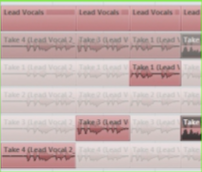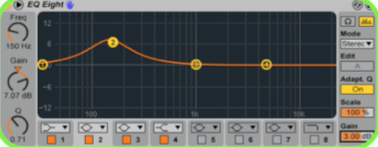Vocal Editing
Editing Vocals
Vocals, particularly the lead vocal, are the main focus point in most tracks, and not surprisingly this is the area where we spend perhaps most of our time and attention during all the stages of production. When mixing, some engineers choose to start with vocals first, or drums and vocals; others prefer to build the backing track and add the vocals at a later stage. Vocals in popular music are usually divided into two categories: lead vocal and backing vocals (BVs). Their basic treatment is quite similar (i.e. EQ, comp and further processing), although their place in the mix is quite different.
The key to a great vocal sound is at the recording stage. Factors such as the environment (vocal booth), microphone, mic preamp, A/D converter, and of course a great singer are all components of the final result. Today we will discuss some of the aspects of mixing recorded vocals in the context of popular music. Ideally, when mixing you should have one master lead vocal on one track, and other vocal parts such as a double-track and harmonies on separate tracks. However, you might sometimes be given a song with multiple takes of the lead vocal and you will have to decide which one is the best.
(Multiple takes of vocal)
Comping Lead Vocal
Even great vocalists sing better on some takes than on others, so it is common practice to record the same vocal part several times and then compile (or ‘comp’) the best phrases together into the final take. This is easy to do in a typical DAW, as you can view the various takes on adjacent tracks, audition them, then separate out the phrases you wish to keep and move them to a new track. If you only cut in between phrases, your edits shouldn’t be audible, but if you have to edit during a continuous phrase, try to edit either just before a hard consonant or during a sustained sound such as ‘eeh or ‘aah’, using a short crossfade to hide the transition.
Comping Vocals
 Breath noise is a natural part of singing, and if you remove it completely, the resulting track can sound unnatural. You can reduce excessive breath noise by manually selecting the offending sections of the audio file and doing a destructive gain change to reduce the level by a few decibels or, if you’re a little more cautious, you can use mix automation to do the same thing. It’s also often possible to use a gate processor, setting the amount of gate attenuation when closed to around 6dB, rather than having it mute everything completely. The same technique can be used to reduce headphone spill in sections where there is no singing, but this problem is easily avoided by using closed headphones in the first place.
Breath noise is a natural part of singing, and if you remove it completely, the resulting track can sound unnatural. You can reduce excessive breath noise by manually selecting the offending sections of the audio file and doing a destructive gain change to reduce the level by a few decibels or, if you’re a little more cautious, you can use mix automation to do the same thing. It’s also often possible to use a gate processor, setting the amount of gate attenuation when closed to around 6dB, rather than having it mute everything completely. The same technique can be used to reduce headphone spill in sections where there is no singing, but this problem is easily avoided by using closed headphones in the first place.
 The use of software has made it far easier to create flawless comp, since you can edit the audio very precisely, as well as using some of the facilities of Midi+ audio packages and plug-ins to fix some possible problems.
The use of software has made it far easier to create flawless comp, since you can edit the audio very precisely, as well as using some of the facilities of Midi+ audio packages and plug-ins to fix some possible problems.
Creating a perfect comp takes a bit of practice though, as it usually involves a bit more than just putting few phrases together. The result we want to achieve is that it sounds natural, as if it was a one-take performance. If the singer had a bad day, you might have to look into comping words and even syllables sometimes.
With all that comping, be careful to keep the breathing in, as an ‘airless’ performance can sound very unnatural, to the point of becoming uncomfortable to listen to. However, if some breaths are too loud in level, you can turn them down as long as you don’t lose them altogether.
Sometimes you might have to use crossfades between some regions for a smoother transition.
If there is a considerable amount of background noise, you might need to use a noise gate so that the whole take is cleaner and free of noises in-between phrases and parts. Another method with a DAW is to cut out the gaps between phrases or sections, either manually or using software that has a dedicated feature for this application.
Tone Control
Occasionally a vocalist will naturally move in and out of the sweet spot of a microphone whilst recording, changing the tonality and volume of the vocal. If the distance from the mic between two phrases from two different takes is too great, it can make it hard to create a unified composite vocal. Vocal takes that sound thin and further away from the mic can be altered using a plug-in EQ. However, I tend to do it offline, writing the effect as a new audio file so that the whole take is more unified, before adding further processing. For example, add some gain at 150Hz with a wide bandwidth to compensate for the lack of proximity effect, before adding some volume if the take seems to fall away in the mix.

(This technique can help match the tonality and volume of each take to sound like one phrase.)
